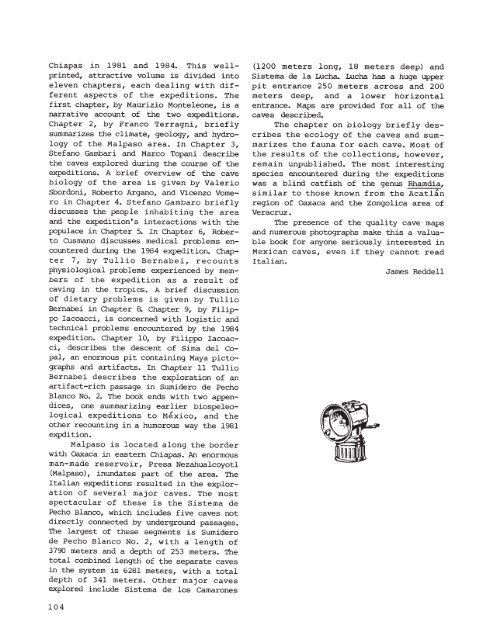8MB PDF - Association for Mexican Cave Studies
8MB PDF - Association for Mexican Cave Studies
8MB PDF - Association for Mexican Cave Studies
- No tags were found...
Create successful ePaper yourself
Turn your PDF publications into a flip-book with our unique Google optimized e-Paper software.
Chiapas in 1981 and 1984. This we1lprinted,attractive volume is divided intoeleven chapters, each dealing with differentaspects of the expeditions. Thefirst chapter, by Maurizio Monteleone, is anarrative account of the two expeditions.Chapter 2, by Franco Terragni, brieflysummarizes the climate, geology, and hydrologyof the Malpaso area. In Chapter 3,Stefano Gambari and Marco TOPani describethe caves explored during the course of theexpeditions. A brief overview of the cavebiology of the area is given by ValerioSbordoni, Roberto Argano, and Vicenzo Vomeroin Chapter 4. Stefano Gambaro brieflydiscusses the people inhabiting the areaand the expedition's interactions with thepopulace in Chapter 5. In Chapter 6, RobertoCusmano discusses medical problems encounteredduring the 1984 expedition. Chapter7, by Tullio Bernabei, recountsphysiological problems experienced by membersof the expedition as a result ofcaving in the tropics. A brief discussionof dietary problems is given by TullioBernabei in Chapter a Chapter 9, by FilippoIacoacci, is concerned with logistic andtechnical problems encountered by the 1984expedition. Chapter 10, by Filippo Iacoacci,describes the descent of Sima del Copal,an enormous pit containing Maya pictographsand artifacts. In Chapter 11 TullioBernabei describes the exploration of anartifact-rich passage in Sumidero de PechoBlanco No.2. The book ends with two appendices,one summarizing earlier biospeleologicalexpeditions to Mexico, and theother recounting in a humorous way the 1981expdition.Malpaso is located along the borderwith Oaxaca in eastern Chiapas. An enormousman-made reservoir, Presa Nezahualcoyotl(Malpaso), inundates Part of the area. TheItalian expeditions resulted in the explorationof several major caves. The mostspectacular of these is the Sistema dePecho Blanco, which includes five caves notdirectly connected by underground passages.The largest of these segments is Sumiderode Pecho Blanco No.2, with a length of3790 meters and a depth of 253 meters. Thetotal combined length of the seParate cavesin the system is 6281 meters, with a totaldepth of 341 meters. Other major cavesexplored include Sistema de los Camarones(1200 meters long, 18 meters deep) andSistema de la Lucha. Lucha has a huge upperpit entrance 250 meters across and 200meters deep, and a lower horizontalentrance. Maps are provided <strong>for</strong> all of thecaves described.The chapter on biology briefly describesthe ecology of the caves and summarizesthe fauna <strong>for</strong> each cave. Most ofthe results of the collections, however,remain unpublished. The most interestingspecies encountered during the expeditionswas a blind catfish of the genus Rhamdia,similar to those known from the Acatlanregion of Oaxaca and the Zongolica area ofVeracruz.The presence of the quality cave mapsand numerous photographs make this a valuablebook <strong>for</strong> anyone seriously interested in<strong>Mexican</strong> caves, even if they cannot readItalian.James Reddell104
















